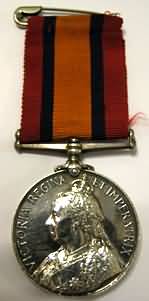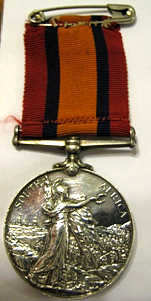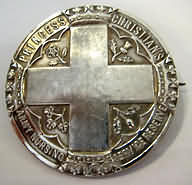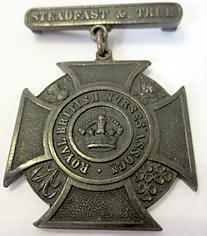|
Collecting Nursing History 30 Nursing Sister Lilian Ainsworth 1872-1951 Sarah Rogers. |
 |
Please Note: Whilst every care is taken in checking promoted links, we cannot accept responsibility for your use of third party web links. | |||||||||||
Pictures of the Queens South Africa Medal, which was issued to Nursing Sister L Ainsworth.
(2)
(3)
Princess Christian's Army Nursing Reserve.
(Fig 5) Lilian is mentioned in Army notices in 1900 published in the Nursing press, "We have been supplied with the following list of Sisters chosen, all of whom have joined the Army Nursing Service Reserve:-Nursing Sisters Miss L. Ainsworth..."(6) Lilian sailed for South Africa, leaving from London on 12th March 1900: "The Avoca, fitted out as a hospital ship, sailed from here (Albert Docks) this morning with the 10 Gen.? Hospital, 4 civil surgeons and 22 Nurses" (1) Lilian appears several times within the war office Queens South Africa medal rolls (7): the entries record where she was working during the Boer war. She worked at five hospitals within that two-year period: · No. 3 Stationary Hospital , Da Ar · No.8 General Hospital, Bloemfontein · No. 10 General Hospital, Norvals Point · No. 5 Stationary Hospital, Bloemfontein, · No. 8 Stationary Hospital, Port Elizabeth. Stationary Hospitals were designed to take 100 casualties, and were designed to be mobile. General Hospitals took approximately 500 patients, and were in tents or in existing buildings, converted for use initially as base hospitals. Nurses were not sent to the hospitals at the front: orderlies cared for the patients in these Field Hospitals, with very rudimentary conditions (groundsheets, no beds/stretchers). (1) The Queens South Africa (QSA) medal was awarded between 11 October 1899 and 31 May 1902 to all Military Personnel who had served In South Africa between those periods. Queen Victoria died on 22 January 1901 and then The Kings South Africa medal was awarded for a very short period to troops, who had both served in 1902 and for 18 months. Consequently, only very few were issued as the majority of people serving only qualified for the QSA medal.Lilian therefore had fulfilled the criteria for being awarded the QSA. She appears to have returned home before the end of the Boer War (31st May 1902) as she does not appear to have received the KSA medal: "Miss Lilian Ainsworth, who was trained at the Royal Hants County Hospital, and subsequently held the position of Sister at the Chelsea Infirmary, having just returned from South Africa after nearly three years' service in the Army Nursing Service Reserve, has been re-appointed to the position of Sister at the Chelsea Infirmary"(8) In 1911, Lilian appears on the census in Birkenhead, apparently living at home with her widowed mother and three unmarried brothers. She gave her occupation as "Sister Army Nursing Service Reserve"(9) Lilians World War 1 records survived the cull in the 1930's of nurses records. Having passed her medical in Chelsea on May Day 1915, and signed her war department contract five days later, she joined Queen Alexandra's Imperial Military Nursing Service Reserve -aged 43 years. (Men over 40 were initially exempt from active service, although some, like my Great Grandfather insisted on going: he was subsequently killed in Passchendaele). Lilian was initially sent to work as a sister in Sidney Hall, Military Hospital, Weymouth. ON 19th July 1915, she was transferred to Egypt, where she appears to work for one year. She embarked in Suez on 16th may 1916, Disembarking in Basra after a voyage of 25 days, joining the British General Hospital for duty on 17th June 1916. Within two months, Lilian was admitted to hospital with sandfly fever and was invalided to India on H.S. Donogola, authorised by the Matron in Chief. SANDFLY FEVER - Sandfly fever was a persistant problem during World War 1 in the Eastern Campaign area, having been endemic in the lowland areas of tropical and subtropical countries. The female midge Phlebotomus Papataci (which translates from Italian to sandfly) transfers it. A few days after the initial bite, symptoms appear, including fever, malaise, headaches, muscle and joint pain, facial flushing and tachycardia. After a few days, the pyrexia subsides, and residual problems, which can remain for up to a few weeks, include; fatigue, hypotension and bradycardia. Complete recovery is the norm. Sandfly Fever is a disease of considerable military importance because, although it is never fatal and has no serious sequelae, it may nevertheless suddenly incapacitate large numbers of men who may be urgently required for important operations." (13) Lilian appears to have recovered, and returns from Bombay to Basra (a seven-day voyage). By 22nd November 1916 and over the following fourteen months, she is posted to several hospitals in Mesopotamia, modern day Iraq: · NO 1 General hospital, Amara · 1 British General Hospital (B.G.H) · 23 British Stationary Hospital (B.S.H) · 31 B.S.H · 23 B.S.H · 32 B.G.H "No 23 Stationary Hospitals was situated higher up the river; it was all under canvas and quickly increased from 250 to 1,000beds. It was the rainy season and one lived in gum boots, wore topees and sluiced about in mud all day long. Fleas plague everyone at this time of year, but sand flies and flies come later. It can therefore be understood that we were not working in favourable conditions. No 23 Stationary Hospital went up to Bagdad in May 1917 and took over the Turkish Military Hospital which was filthy and verminous" (18) On 29th January 1918, Lilian was admitted to No 1 B.G.H, being transferred to the Officers Hospital on 30th March 1918 and invalided to Indian Ambulance Ship Varela, with dysentery. During this time, Lilian is mentioned in despatches "gazetted" for her service: "I have the honour to submit herewith a list of names of those officers, ladies... serving, or who have served under my command, whose distinguished and gallant services and devotion to duty I consider deserving of special attention... Signed F.S.Maude, Lt general, Commanding -in -Chief, Mesopotamian Expeditionary force. Army Nursing Service Reserve Ainsworth, Sister Miss L." (9) DYSENTERY- In World War 1, dysentery was as much a threat to life as warfare. It is an inflammatory disease of the intestine, imparticular the colon, resulting in: severe diarrhoea containing blood and mucous, fever, and abdominal and rectal pain. Caused by dirty drinking water or poor hand hygiene, symptoms could appear within six hours to three days. In WW1, flies, which were carriers, were destroyed and milk and water intake were used with caution. They also destroyed contaminated items: towels, sheets etc. Diets for "enterics" are often mentioned in diaries of WW1 nurses. Treatment then was rest and rehydration, which along with antibiotics' are today's treatments. (15, 16) "With correct treatment, most cases of amoebic and bacterial dysentery subside within ten days, and most individuals will achieve a full recovery within two to four weeks after beginning proper treatment. If the disease is left untreated, the prognosis varies with the immune status of the individual patient and the severity of disease. Extreme dehydration can prolong recovery and significantly raises the risk for serious complications." (15) Over a year later, it appears that Lilian is transferred home to The Queen Alexandra Military Hospital, Grosvenor Rd, London from hospital In Camballa, and Bombay arriving on 19th March 1919. Lilian is noted to have an: "Abscess of neck"(14) Lilian remains an inpatient for one month before she is discharged. Thereafter she has a medical board at Queen Alexandra's Hospital, Millbank in May. Lilian writes from home in Birkenhead on 28th May 1919: "Dear Madam, I have the honour to inform you that my eight weeks leave expires on July 8th. I am feeling stronger for the fresh air and rest though I still have a haematoma of the right side of my neck and that side of my face feels numb and cold for which perhaps something could be done. My speech too is affected especially when tired-there is some slight oedema of my L. foot. I have the honour to be dear Madam, your obedient servant... Lilian Ainsworth Q.A.S.M.N.S. (R)"(14) It is hard to see that these symptoms are related to dysentery and may be more related to the neck abscess or another disease. From reading WW1 nurses diaries, many seemed to get abscesses with regularity. This may be in part due to a restricted diet when working in a war zone, especially in Lilians case when working in: "Conditions in Mesopotamia defy description. Extremes of temperature (120 degrees F was common); arid desert and regular flooding; flies, mosquitoes and other vermin: all led to appalling levels of sickness and death through disease. Under these incredible conditions, units fell short of officers and men. Medical arrangements were quite shocking, with wounded men spending up to two weeks on boats before reaching any kind of hospital." (17) One month later an extension of sick leave for Lilian is granted , with the request to order a medical board, this time at western central, and this comment underlined in red ink: "Terminate when fit, not suitable for further service"(14) Lilian is finally declared permanently unfit for service on 11th September 1919, with a written comment "not insured," and a note from The Matron in Chief/or her office: "Will you please consider this case for impairment grant? Disability attributable to Military Nursing Service for King." (14) It is unclear whether Lilian did receive a pension, and aged 48 years is no longer well enough to work. The only trace of her in the nursing press after this is in relation to the Royal British Nurses Association. On three occasions: 1921, 1923 and 1928 she is documented as making £3 donations, twice to "The Club"- The Nurses Own Club and once towards the purchase of 194, Queen Anne's Gate, London, the location of The Club.(9, 10, 11)This would suggest that she was financially secure-these donations equate to a donation of £60 today.(19) Lilian died at the family home in Birkenhead on 10th January 1951, aged 80. Probate was granted 11 months later to one of her brothers: Ellis Ainsworth a retired bank manager. She left an estate worth £6447 (2); today's value approximately £146, 862. (19)
*
Royal British Nurses Association
(Fig.4) Bronze Badge of the Royal British Nurses Association "This was designed by H.R.H. Princess Christian who gave it her father’s motto ‘Steadfast and True’. Shortly before her death in 1923, H.R.H. Princess Christian told an officer of the RBNA ‘I have loved the Association and I gave it my father’s motto’. Through the long struggle for the Registration Act, her words came true ‘The Association shall choose the course it thinks right and it shall stand firmly by it." (4) Dr and Mrs Bedford Fenwick founded this in 1887. They along with several Doctors and Matrons were interested in founding a nurse's version of the British Medical Association. A council was created, and constitution drafted. Along with Matrons and nurses, doctors were also members. Its seems very male dominated, and to us now strange that male doctors men should have been included onto the Council , and had a large part in the new association. In 1890, the female vote was a long way off being achieved; the National Suffrage movement had been established in 1872, but did not take off until the early 20th century. Princess Christian was the president of the first nurses association in the world. Many members were mainly from the Middlesex and St Bartholomew's, other London teaching hospitals being rarely represented. There was much opposition, not just among other nursing pioneers such as Florence Nightingale and Eva Luckes, but also the Nursing press. In 1898 The Nursing Record and Hospital World is very scathing about this by now 10-year-old association (3) and suggests that Lilian, whose name as Honorary Officer along with several others, was withheld by their own wish! (Which the press subsequently published). A charter was granted in 1893, which was followed by a Royal Charter. "Now that the name of every intelligent person of independent views has been removed from the Executive Committee and General, Council. The services of the staffs of these institutions will no longer be required to outvote and howl down their colleagues, because all self-respecting and honourable nurses will refuse to accept office under the present Hon. Officers and their unscrupulous supporters." (3) Many were vociferous in their support against nurses registration, - a cause which united Eva Luckes and Florence Nightingale. Eventually an act of Parliament was passed in 1919, leading to the first registrations in 1921- the first being Mrs Bedford Fenwick.
1. www.boerwarnurses.com/web/database.html 2. Ancestry.co.uk 3. http://rcnarchive.rcn.org.uk/ Nursing Record and Hospital World Volume 21, 2nd July 1898 (p5) 4. http://www.rbna.org.uk 5. http://rcnarchive.rcn.org.uk/ Nursing Record and Hospital World, Volume 29, 20th September (p231) 6. http://rcnarchive.rcn.org.uk/ Nursing Record and Hospital World, Volume 24, 17th March 1900 (p212) 7. The National Archives, Kew, QSA Medal Roll WO 100/229, pg's 55, 62, 95. 8. http://rcnarchive.rcn.org.uk/ The British Journal of Nursing/ Volume 29, 20th September (p231)- 9. The London Gazette, Supplement to, 12th March 1918, pg's3111& 3118 10. http://rcnarchive.rcn.org.uk/ The British Journal of Nursing/ Volume 66, June 25th 1921, pg 385 11. http://rcnarchive.rcn.org.uk/ The British Journal of Nursing/ Volume 70, June 2nd 1923 pg 347. 12. http://rcnarchive.rcn.org.uk/ The British Journal of Nursing/ Volume 76, November 1928, pg 293 13. HTTP://NZETC.VICTORIA.AC.NZ/TM/SCHOLARLY/TEI-WH2SURG-PT2-C7.HTM 14. The National Archives, Kew, and WO: 399/43: Lilian Ainsworth 15. http://en.wikipedia.org/wiki/Dysentery 16. http://typhoidfeverdysentery.weebly.com/ 17. http://www.1914-1918.net/mespot.htm
18. Members
of Her Majesty Queen Alexandra's Imperial Military Nursing Service
(1922). Reminiscent 19. http://www.nationalarchives.gov.uk/currency
1-5 Copyright Private Collection. Acknowledgements: With many thanks to all those people, who answered my many email questions, and in particular: Will Burgess, Webmaster@schoolsofnursing.co.uk for proof reading, editing, encouragement; Keiron@Boerwarnurses.com and lastly but not least my very supportive husband, Harry. © Sarah Rogers 17/08/ 2013 |
SECTION
1 Schools of Nursing. SECTION 2 |
||||||||||||
| Home Schools Region Forum Collecting Galleries History Bibliography News Archive Contact |




